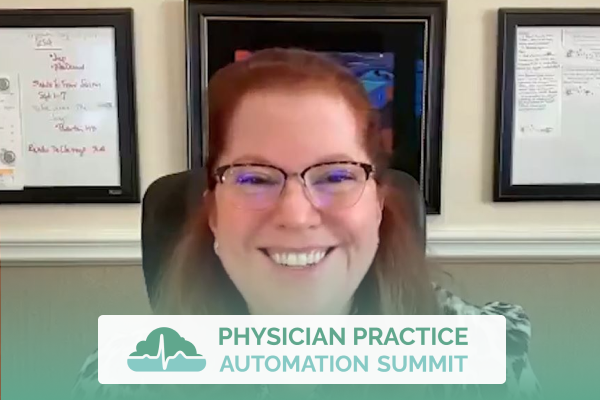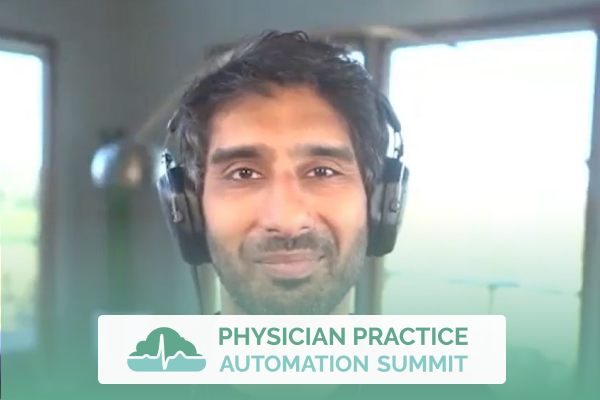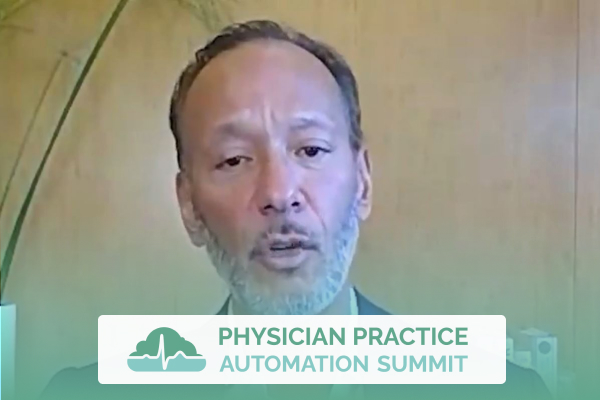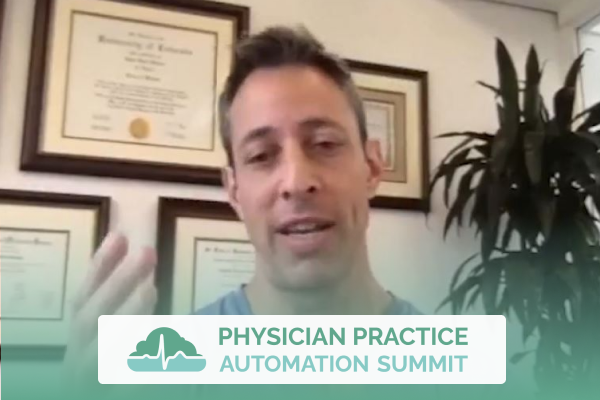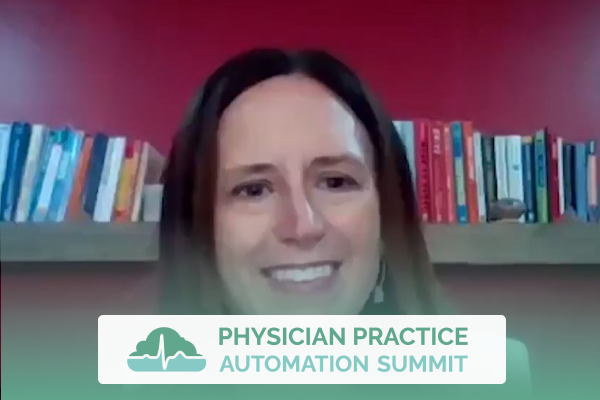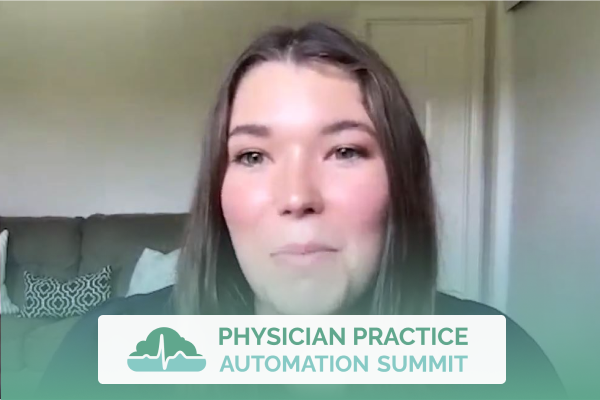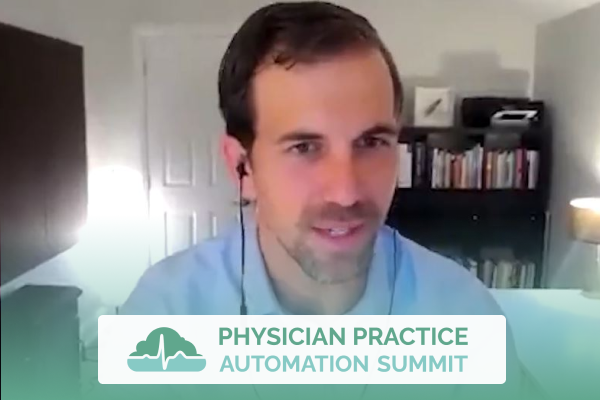Join the discussion below
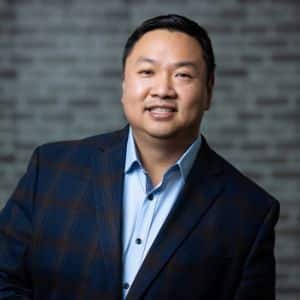
Dr. Ruan is the Founder and CEO of Texas Center for Lifestyle Medicine. He devotes his career in practicing and building systems that allow for efficient delivery of healthcare. He is a board certified internal medicine physician but also have advised with companies to improve their workflow, company culture, marketing,... Read More
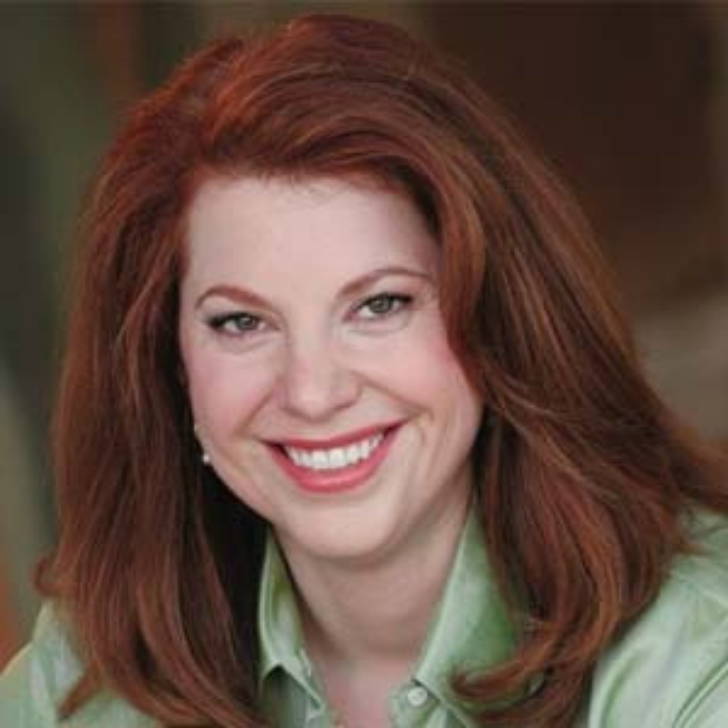
Halee Fischer-Wright’s passion to help people led her to become a physician. Today, that same passion drives her work as a bestselling author, a speaker, a healthcare and organizational strategist, a leader, and a coach. Halee has spent the past 16 years becoming an expert in organizational culture, strategy, and... Read More
Cheng-Huai Ruan, M.D.
So excited to introduce Dr. Halee Fischer-Wright. Halee has been spending the last 16 years becoming an expert in company and organizational culture and strategy and some turnarounds. She’s the president of Rose Medical Group, and she helped grow the organization to 560 physicians, which is mindblowing. She is the CEO of the Medical Group Management Association, or MGMA, that most people know, which represents a majority of the physician practices in the United States, which is a very, very large endeavor. Together with executive teams, she’s worked to grow the MGMA membership from 30,000 to 58,000 while focusing on lean and sustainable operations, which is totally what we’re gonna talk about today.
Very innovative person. She co-wrote one of my favorite books, which is “Tribal Leadership”. It’s actually one of the books that led me to want to open my own practice with a different type of leadership, and I still go back to it to this day. She’s named a top 100 health care leader and top 25 women in healthcare by “Modern Healthcare” and a 100 great leaders healthcare by “Becker’s Hospital Review”. So, lots of awards. She’s been on “Forbes” magazine and “Modern Healthcare”, and she’s been a speaker and a panelist at humongous regional and national events, so really honored to have her here today with us. Well, thanks for coming on. I’m so happy to have you, really excited to have this talk. How are you doing tonight?
Halee S. Fischer-Wright, MD, MMM, FAAP
I’m doing well, Cheng, thank you so much for the invitation. I appreciate it.
Cheng-Huai Ruan, M.D.
Yeah, no problem. And believe it or not, I’ve been following you for a long time. What you don’t know is that “Tribal Leadership” was literally the reason I opened my practice in 2017.
Halee S. Fischer-Wright, MD, MMM, FAAP
Wow.
Cheng-Huai Ruan, M.D.
Yeah, so, at that time, Texas Center for Lifestyle Medicine, I really wanted to redefine what it is, because I was in a previous practice and my slots were 10 minutes and I was averaging, I track everything, so I averaged about 6 1/2 minutes per patient. And it was just not the best model in the world. But it’s your typical internal medicine, inpatient, outpatient, ICU, and hospice. It’s a working model for some, but for me it wasn’t really fulfilling. I knew that I needed to build a team, so “Tribal Leadership” was a fantastic book to lean on. And so, that’s why I’m super happy to have you on. So, thank you very much for that.
Halee S. Fischer-Wright, MD, MMM, FAAP
It’s a pleasure.
Cheng-Huai Ruan, M.D.
And so, I wanna jump right into it. Most, majority of the people that are watching this, if not all, are physicians. Most are physicians either in private practice or about to go into private practice or considering private practice, or some of them are just considering retiring. So, back to that as well. I think that with the pandemic and the pandemic era, practicing medicine, so I’ll tell you what we did at Texas Center for Lifestyle Medicine is that in February of 2020, we decided that after the initiation of the lockdown that we should just switch to telemedicine. We went from 5% telemedicine to 80% telemedicine, closed off our satellite locations, and concentrated into one. It was a very difficult business decision. But it really came from a podcast I actually heard from MGMA, believe it or not. And you weren’t in that one, but really talked about what to do, telemedicine communication. And so, I was lucky to really have that information. But right now, we’re, I mean, I would like to say we’re coming out of the pandemic. It just seems like we’re perpetually in one. What can doctors do in private practice to tap into some, like the latest resources to pivot during this pandemic era? It’s very hard.
Halee S. Fischer-Wright, MD, MMM, FAAP
Absolutely. I think, so this is, I’m the CEO of MGMA, and what we do is we really do have an understanding of what’s going on across the country. And it’s very much, Cheng, what you described. It’s not unique to, a lot of times when we talk about these problems, it may affect people in Texas more, or Florida, or Northeast, or out West. This is across the board. And so, the pivot that you did in transferring from being really face-to-face to telemed and really pulling the lever on, what are the inefficiencies and letting it go. This is a tough business decision, but this is what we need to do. I think it speaks to a couple things.
Number one, being able to resource so that you can understand what’s going on across the country and recognize that this is not unique to you. Number two, through either of your medical specialties, I’m gonna assume that there’s all medical specialties listening to this podcast or to this interview, that you have medical specialties that really focus in on what are the business needs of each one. But then, when the pandemic occurred, and by that, I mean, between March and mid-April, almost all of the large medical, the more general medical associations got together and said, “What are the resources we can create?” And then we allowed everybody to access that. So, even if you weren’t a member of a AMGA or HFMA or MGMA, you were able to access those pandemic resources, and those are still available right now. As we go into this wave of Delta, I think we’re renewing, what do we do, how do we refine? And so, in a certain way, your pivot, Cheng, for, we’re switching how we communicate and how we do business and now we’re gonna have to iterate on that model, I think is really what we’re looking at. And so, those resources include a recovery checklist that you can get through your medical specialties, societies, through MGMA, once again, AMGA, et cetera.
Those resources are out there, you just have to seek them out. I think one of the things that we’re gonna talk about is saying, allowing yourself, the number one research you can give yourself is time to pull your head up and assess what’s going on and make a decision of what resources you need to move forward. And I think that’s the one thing we don’t talk about enough is actually creating enough space to figure out what your business needs are.
Cheng-Huai Ruan, M.D.
It’s overwhelming, right? I think that when, in 2017, when we first started doing telemedicine, we had to pivot because my practice opened six weeks before Hurricane Harvey hit Houston. And for a period of time, I didn’t know if we were gonna continue on. So, we had to pivot to telemedicine because of Hurricane Harvey at that time. And so, we were able to smooth that over a bit. And then with the pandemic, I mean, it’s a whole different level. At that time I really held on to the Texas Medical Association, TMA, and they have all these resources out there, which is wonderful. And now with the pandemic, it’s a whole other level which I didn’t think I was gonna see again since trauma that occurred with Hurricane Harvey, right? With the pandemic, it’s now everyone’s really affected, and now we know it’s not gonna stop. This is a new level of normal. And I think that when I talk to my physician friends, they’re like, “Oh, we’re just gonna wait for this to kind of blow over.” It ain’t blowing over.
Halee S. Fischer-Wright, MD, MMM, FAAP
What I’m seeing in the leadership ranks and what I’m starting to write extensively about is that the irony of COVID is there is no trend that was occurring in medicine that isn’t present during COVID, but it’s like it got put on steroids. Everything that’s coming, telemedicine, move to the billing challenges, the staffing challenges, all these things, burnout, all these things preceded the pandemic. But now 18 months later, they are all viciously apparent. And I think one of the things that I’d love for people listening to this and watching this to come out of is, it’s at these times that, you know, I’m a Gen Xer, the “Dare to be great” situation, where you really do have to say, I think one of the things about being Gen X, Gen Y Gen Z, is that your frame of reference is, okay, we’ve gotta change. And that there’s a certain amount of flexibility, even in Baby Boomers, certainly, how do you change? And you have to have an appetite to do that as well. What you’re talking about, first of all, you went through a catastrophic once-in-a-lifetime hurricane and the flooding in Houston, right? And you follow that up by a once-in-a-hundred-year global pandemic. I mean, you’re a tested leader at this point in time, right?
Cheng-Huai Ruan, M.D.
I would hope so, gosh.
Halee S. Fischer-Wright, MD, MMM, FAAP
Knock, knock, knock.
Cheng-Huai Ruan, M.D.
I know, right?
Halee S. Fischer-Wright, MD, MMM, FAAP
What you’re looking at is, when you come through the second time and I know that part of your summit is around trauma and there’s significant trauma. But also through that, there’s a sense of pride and accomplishment that you’ve led your business through two catastrophic events and you’ve come out on the other side. Now, granted, to your point, COVID isn’t over. But the first wave where we shut down the economy of the United States, that part is over. We’re not gonna shut down the United States. Now we have to figure out, how do we operate in a COVID world, which is a different challenge than, how do you make it through everything being shut down.
Cheng-Huai Ruan, M.D.
That’s a great point. But I think my issue with the way that medicine has been taught, so I finished residency in New York in 2012, the chief resident year in 2013. And my sister is currently at Columbia University School of Medicine in her fourth year. And so, I think that the way that the educational institutions has been responding has, they also have a very large burnout because a lot of things that were taught within institutions and outpatient medicine, inpatient medicine, all of the curriculum just blew up. They’re like, “Oh, my gosh, what do we do now,” right? So, my sister, we were just talking about this yesterday, how right now it’s like people are so scattered. Administration is scattered.
We’re talking about an Ivy league school here. So, administration is scattered. You have doctors that are scattered. Nurses are scattered, and everyone’s at each other’s throats. And one of the things that, once again, going back to “Tribal Leadership”, is just going from talking about different stages of the cultures of the business. And within a lot of the institutions, they’re at this stage where people are just like, “You know, my life sucks.” And transitioning that to a higher stage, as you talk about in the book, is just very difficult. And I think when COVID happened, that happened across the country. The cultures of each of the private practices really were challenged. And then all the deficiencies within each type of culture was on full display. And now we’re in this rut, so what do we do? How do we get out of this?
Halee S. Fischer-Wright, MD, MMM, FAAP
The point that you’re making has to do with systems thinking. We had an entire system. I maintain healthcare isn’t a system, it’s an industry, because it’s not closed. But let’s say, for the purpose of this conversation, it’s a system. We applied severe pressure onto the system. We shut off, really, all financial resources. We took away safety equipment. And then depending on what geographic area you were, we inundated with unbelievably sick patients. And we didn’t have the education. We didn’t know enough about the virus, if you were a physician or nurse or working in a hospital, to know that you weren’t gonna bring that back to your family. So, there was that element of fear that’s on top of everything else. The thing about systems, and I think my entire career speaks to this. We always look at the policy people that push policy down and will make it, you know, “Medicare will fix this.” My stance is control what you can in your world.
If you can control your practice, make shifts in your practice, make shifts in your world, that will affect the entire system over time. And so, when people are saying, “Well, I have no control “and I can’t do this and I can’t do that,” I often say, “Let’s take a look at the domain of control “that you do have within your practice.” You don’t even need to be a practice owner. I mean, you could be a physician and say, “What do you have control over?” We’re gonna talk about burnout. I know you are gonna talk about burnout. When I look at burnout, I think 50% of burnout is stupid processes. In other words, we keep, as physicians, getting more and more pushed on top of this, but we’re not removing anything. So, we have all these regulation and all these protocols and policies and everything else, and no one ever sorted through this actually is important and this doesn’t matter anymore. And so, if you can start with something super basic of, I have control of this 24 by 18 inch space, manage this the best and then slowly extend. I think there’s a sense of, you need wins. I think as physicians, we haven’t had wins in a while. That’s how you start, with the wins, and start developing that momentum, the whole Jim Collins philosophy of getting enough momentum to move the flywheel. As physicians. we don’t collaborate enough, really, to get a flywheel going. But we can get our own motors going if we have enough small wins.
Cheng-Huai Ruan, M.D.
Yeah, in my organization we call them micro-Ws, micro-wins, right? And even something as a simple thank-you text message from a patient through our text platform, that’s a big win. I try to focus on those things as micro-Ws, micro wins. And these micro-Ws add up to a macro-W, which we celebrate once a month, ’cause we have meetings once a month. We shut down the whole clinic, have our whole staff in once a month. And so, that’s really changed a lot of the processes that we do. But earlier you said 50% of the burnout is processes. I feel like for me, that’s 95% of my burnout is that-
Halee S. Fischer-Wright, MD, MMM, FAAP
Then let’s clarify. At least 50% is.
Cheng-Huai Ruan, M.D.
But I think part of it is to recognize that burnout is from an impaired process, an impaired system, not documenting. And we have other parts of the summit we actually talk about exactly how to do that, document systems. I think the big challenge in my physician group and especially on these Facebook groups, stuff like that, is that right before our talk, as inspiration, I actually go into these physician Facebook groups. And I just see the last 10 posts of what people are talking about. Very few of the posts are very positive in general. A lot of times it’s, okay, my staff won’t bring me water, or, “I have this employee is doing that “and it is making me look bad and I got a one star review “because this employee is doing that.” And so, I think there’s so much external blame that the physician’s casting on a single person, but really, it’s the system that’s involved, right? And so, I wanna just go in there and talk to them on social media. It’s like, yeah, it might be a system thing. But the problem is that every post is basically a pain-point of impaired systems in the process, whether it’s talking in leadership impairments, no processes for patient engagement, and a lot of things are expected. And so, I think that as doctors, we were trained and I was trained that, hey, learn what you can in medical school in residency. You go out, be a good doctor, and everything will follow through. I’m not finding that to be true.
Halee S. Fischer-Wright, MD, MMM, FAAP
That’s true. I think it’s interesting what, I think this is very normal in physician culture, and I think physician culture, and you’re familiar with this if you’ve read “Tribal Leadership”. It’s almost like I try to one-up you with how much my life sucks.
Cheng-Huai Ruan, M.D.
Yes, yes.
Halee S. Fischer-Wright, MD, MMM, FAAP
And the good news as physicians is we have endless fodder to fill that well. That well will never get filled. What we’re not, and we’re trained that way. We heard our chief, when we were baby doctors, we heard our chief residents complain like that. We heard the people above us complain like that. And then really, we got cultured, accultured into doing that as well. It’s a rite of passage. I mean, I finished med school 20 years before you, but you know, when you went to a morbidity/mortality conference, that was the pinnacle of, “My life sucks.” It was never good. Trust me, if you were presenting, it wasn’t good. Oftentimes, when I, and it’s actually why I don’t Facebook. I’m active on social media, but not Facebook, because I think it’s almost too easy to throw garbage on the garbage pile.
I think what’s much more hard and what’s much more leadership behavior is to acknowledge the pain points. And there are, so I’m not saying, “Oh no, everything’s great.” What I’m saying is, acknowledge the pain points and then say, “Great, what have you thought about in how you solve this? Or, “How would you approach it?” When I took over the organization that I took over, they were awesome at complaining. I mean, fantastic. Five star. And I would say, this is a 95-year-old organization. I have no doubt this complaint was present in 1926. So, what solutions have been tried over the last 90 years that have worked, haven’t worked, what have you thought about? And I try to move it. I mean, you do have to acknowledge the pain points ’cause it is, it’s awful. And to move out of the, “I’m a victim,” into, “I’m empowered,” which I think is really important as physicians once you can understand what your leverage is. But that shift from, “I experience nothing but pain,” into, “How can I turn my pain into power?” And by power, I mean ability to do something about it, ability to wield influence in a, and I would like to say in a positive way. That is the shift that I think that we’re poised on. We could either go all to victims as physicians, or we could move into, this is the time that physicians actually take the rightful place in the system of how to take care of patients and start to lead what care looks like in the next generation. That’s the cusp of where we are right now.
Cheng-Huai Ruan, M.D.
Yeah, so I think with coronavirus, it’s really challenging that aspect. I think that as physicians, especially physician leaders in private practice or any practice, we have to recognize that we’re leaders, too. But I think we’re also reacting to a lot of trauma from, could be residency or medical school, because I feel like, and I talk to my friends about this all the time, that we went into medical practice, well, we went to medical school for a reason. And perhaps somewhere along the way, we realized that the reason that we went to medical school for is not necessarily we’re gonna get out of it, but we’ve invested so much time and money and effort into it. And so, for a lot of people, it’s like, there’s little disappointments along the way. And then now you’re just like, “I’m just gonna follow the leader, “’cause I’m. $280,000 in debt. “I’m just gonna keep following the leader.”
And then the leader could be this attending of the ICU at Columbia, Presbyterian, whoever it is, right? And then when something doesn’t necessarily match that hierarchal structure, there’s this, we become afraid almost, because as physicians, we’re taught to practice the standard of care in medicine, do the thing that’s right. But from a personal development standpoint, our standards really have to change in each phase of our career. And I feel like a lot of people are stuck in the past, not changing into that sort of mindset. I felt like that a lot in my first practice after chief residency.
And I felt like, yeah, the money’s good, everything’s great. But it’s like the, you know, my mom’s an acupuncturist, very holistic family in general. I’m like, I went into this to have better conversations. I didn’t go into medicine to prescribe medicine. I went into medicine to have better conversations. But I feel like my 6 1/2 minute visits were not better conversations. And my favorite time in practicing medicine in my previous practice was hospice. I loved hospice. I got to talk, I got to interact with the patient’s family, and it was something that’s really fulfilling. And I’m like, well, should I be a house doctor? And then I read “Tribal Leadership”. I was like, oh, wait a minute! This is a new standard, right? There’s actually a mentality that’s outside of what I learned that I wanted to pursue. And the whole point of this entire summit is to get people to understand that there’s something else there to pursue that’s not the standard of care, standard of practice. So, how do you achieve that? How do you foresee that one achieves that?
Halee S. Fischer-Wright, MD, MMM, FAAP
Yeah, I think, okay, that’s a massive question, so I’m stalling while I populate my index cards in my head. I think the first step is acknowledging this isn’t working. I think, Cheng, it was your first, what you just said. We’re accustomed to complaining about things. We’re not accustomed to just basically saying it’s not working. And then here’s the next step, which you did beautifully. “I’m not gonna do this anymore. “It doesn’t make sense,” right? When you get to that point that you’re frustrated or tired or, let’s be honest, traumatized, the pain is enough that you’re willing to make a change.
As physicians, there is a, I would say legend that we have in our head that we’ve gone through all this training, we’ve spent all this money, we’ve been up all these nights, we’ve suffered. So, when we get to be attendings, it should all be good and easy. And none of us have experienced that. I mean, the thing is, I finished my training 20 years before you did, but I will tell you what you said is, “Well, you know, I figured out and I was already 30,000,” or excuse me, “$300,000 in, it wasn’t gonna be what I,” it’s funny, I would’ve said the exact same thing 20 years ago. I mean, I’ll just be honest with you. I’m like, well, here’s what I’ve told people. We were the last generation, I mean, we were the first generation that followed the “It’s Good” generation.
And having had multiple students go through my school, through my clinic when I was practicing, and then through MGMA, what I realized is we all feel the same way. But you get to that place where you just, it’s what I call the Martin Luther moment. “Here I stand, and I can do no other.” You have to be willing to make a change. And that, I think that’s really hard, especially if you’re an adult, especially if you’ve got family, you’ve got commitments and everything else. You have to be in enough pain to take a risk to do something different. Either speak up, leave, try something, try anything. But that’s where that movement from victim to empowerment occurs is. And we’re human beings, so we’re not gonna do that if we’re comfortable. I mean, that’s really what happens is if you’re totally comfortable and things are okay, eh, might be inconvenient or whatever. But when things really hit that rock bottom, that’s typically when we see people interested in making change and can’t do it fast enough.
Cheng-Huai Ruan, M.D.
Yeah, that’s such a great way to put it. And I tell people that there’s a, there’s evolutional biology says that you’re too comfortable, your species goes extinct. There’s longer anywhere to go, yeah.
Halee S. Fischer-Wright, MD, MMM, FAAP
I mean, This is very cynical, so forgive me. But I think as I watch a lot of our baby boomer physicians retiring, where they’re just like, “Yeah, I’m not gonna do this anymore “and I’m just gonna leave,” as opposed to, which leaves us to fix the problem. And it’s that adapt, migrate, die. It’s the evolutionary prerogative, right? I have unbelievable faith in physicians to adapt to the changes. But to your point, Cheng, nothing that we’ve done before has prepared us for the world that we’re going into, which means, and here’s the upside. We can create whatever we want. And I think that’s the way we have to look at it. We don’t have to keep repeating what we’ve always known. We can be creative. We can put our talents to use. What I thought was really interesting, what you just said is you enjoyed being a hospice physician because you got time to spend with your patients and talk to them. And look, let’s be on it. At the moment of need of human beings, which if you interview physicians, 80% of people that become physicians say they went into healthcare because they wanted to help people. And we’re seeing the biggest frustration is they don’t feel like they’re helping people. They feel like they’re inputting data into a computer, right?
Cheng-Huai Ruan, M.D.
Totally.
Halee S. Fischer-Wright, MD, MMM, FAAP
So, now that we’ve gone through the pandemic and we’ve done the 8:00 p.m. hells, and that’s gone now, how do we take that goodwill and that sense within us of, this is unsustainable, and make change? And I think that’s very individual-driven.
Cheng-Huai Ruan, M.D.
Yeah. Recognition of that this is just not working is the hardest thing that I’ve ever done. And I did it six or seven times, even in the last four years of developing my practice and talking and redirecting and trying to understand what my core values are, what our practice core values are as a company. And then also putting trust in my team, every member of my team, my practice. Doesn’t matter if you’re the janitor or the front office, back office, the medical assistants. We have a culture there and we’re bonded very tightly. And so, I think that what a lot of physicians really discovered, especially since the pandemic, is that the culture glues a team together. Turnover was massive. Employee turnover was absolutely massive during the pandemic. So, on one hand, you have this doctor that really wants to say, “Hey, this isn’t working, I wanna try new things.” But is like, “Oh my God, four of my MAs just quit!” How does one sort of balance that?
Halee S. Fischer-Wright, MD, MMM, FAAP
This is that whole Maslow’s hierarchy. You have to provide your survival, which is you need to see a certain number of patients to provide. And this is a time, solving the, what do I do about my staff, that dives into the whole point of your summit, which is about the use of technology. And may I add the appropriate use of technology, which has not historically been the right place for technology in healthcare. In the fantasy, this would be the situation where we start to use technology to do what it has the potential to do, which is to allow physicians to deliver care more efficiently, more effectively, and patients to understand, as opposed to acting as a barrier to engaging with patients. When those four MAs leave or those theoretical MAs leaving, then I think it’s a good time to say with someone you trust within your practice: Do we need to replace all four MAs? Are there other ways to do this? Where could we use technology to help us out, if that’s appropriate? And if not, how are we gonna revise our systems to be more efficient to absorb this? And Cheng, every single practice administrator I’ve spoken to is undergoing this challenge with staff, so this is not unique.
You know, it used to be, when I owned a practice, we would have our, we had image, we had a good culture. But if another practice offered $4 more an hour, they would go across the street, right? Now, for a lot of MAs, it’s about life and death. “I’m not gonna do this anymore.” So, you’re not replaced. It’s not like the cycle of MAs is coming through. And so, I think there’s a double edge in solving this problem, which is if you’re taking a look at your entire practice and saying, “How do I solve for this problem “in a way different than I just need four more bodies,” you may actually solve for some of the challenges that maybe had one or two of those four walk out the door. The frustration, the boredom, the tediousness of their job.
Cheng-Huai Ruan, M.D.
Yeah, you’re absolutely right, ’cause I actually saw this firsthand where a big portion of our staff are actually virtual assistants. They don’t physically, aren’t in the office. And from a fixed cost standpoint, significantly cheaper, but they always overdeliver, which is great. And so, when another practice decided, said, “I can’t afford the rent anymore “and we’re gonna go virtual medicine for most of it, “and we’ll go down from 1200 square, “or 12,000 square feet to 3000,” my recommendation is, “Hey, why don’t you try virtual assistants?” Because they had six or seven staff members leave, and including the office manager. And so, they ended up, and this is six months later, I think? He told me that his office manager is now completely virtual and did a significant better job. And then half the staff was actually replaced by virtual assistants, so they don’t need to be in the office.
But they can be there to help the patients 24/7, ’cause part of it’s there on nights and part of them are on days. And we were just talking about it. I’m like, “Hey, let’s go to Google. “Let’s look at your last online reviews.” And he never looks at his online reviews. I look at every online review. And we look at it, I was like, “Wow, people are really respecting, “like, who is this?” “Oh, that’s my new virtual assistant “we just hired two months ago.” So, I think that this does exist and that pivoting does exist and at significantly reduced fixed costs. And he actually came out of it better than he did going in. I was just saying, I was just thinking about that example. But I think that people really have to have understanding that, hey, hey, this happened. Let’s think from a global perspective, a top-down approach how to act upon that.
Halee S. Fischer-Wright, MD, MMM, FAAP
And the knee-jerk reaction is just fill those four spaces, right?
Cheng-Huai Ruan, M.D.
Right, right, right.
Halee S. Fischer-Wright, MD, MMM, FAAP
That, in the spirit of the world has changed, it’s not that you have to do better. You have to do different. And I think the other thing that I’d like to share, and you actually mentioned this in our conversation. One of the things that I tell my organization is I expect you to fail. ‘Cause as physicians, we don’t like to fail, which means we won’t risk, ’cause we might fail. So, I tell my staff, I expect you to fail. I’d like you to fail fast and cheap and only fail one time doing the same thing. These are the guidelines around failure. But try something, try anything.
Take a risk, a calculated risk. But some of these will, most of these will fail, some of them will pay off. And once in a while, you’ll knock it out of the park. The strides that we’ve made during COVID had to do with us taking risks. If we want to continue to do what we did every day in and day out, we wouldn’t be here, either. The story you tell about your friend and about yourself basically coming out of COVID saying, “I actually did better than going in “for a variety of reasons,” I won’t say that’s a common story, but I’ve heard that enough to know that there is room for that type of development.
Cheng-Huai Ruan, M.D.
Yeah, I know, and that’s so powerful. So, earlier you talked about technology and you said some are good and some are bad. Can you expand that a little bit? What’d you mean by that?
Halee S. Fischer-Wright, MD, MMM, FAAP
I think that, let’s take wearables out of this conversation. Let’s just talk about the business software. When technology entered into the medical practice, the entire source of that was for billing and compliance issues. It wasn’t engineered to be end-user-friendly. It wasn’t engineered to enhance the patient encounter. It was engineered to capture charges, to be efficient, and to provide compliance with billing. That was it. And to be honest with you, from a standpoint of that was the goal of that software, the initial electronic health records and things like that. But the dream of electronic health records was that every patient would have a portable medical history walking with them. The reality is it became a tool to communicate with health insurers. Now we’re in version, I would call it 4.0, where we’re starting to see end-user meaning both the physician or provider and the patient having some quality with it. And I think as we add in AI interfaces that help bridge the gap with the tedious stuff that you don’t need a physician who’s been in medical school and residency for 14 years to go check, check, check. That’s what an AI interface is for. Now we’re seeing where technology can actually come in in a meaningful way and actually enhance the physician-patient relationship, as opposed to being a barrier to the physician-patient relationship.
Cheng-Huai Ruan, M.D.
When this technology first came out, and you talked about end users, what the EMR was supposed to be, which I thought, ’cause, you know, I’m, my first, no. Yeah, my first year of medical school I was in the hospital, it was all paper. They were using medical students like myself to transition into electronic, which was Meditech at the time. Yeah, Meditech, exactly. And I just thought, wow, this is great! I don’t have to read illegible handwriting! About my third year of medical school, I’m like, I am so sick of this system because now there’s so much more work to be done. Like, what happened here? And now with our current EMR in clinical practice, a lot of things are just big question marks and I feel like a lot of customization needs to be done.
So, the technology is there, but is it utilized fully by doctors to improve their lives? No, it’s really not. I’ve been going to the eClinicalWorks conference for the last three years and trying to improve everything. I learned more and more things. And now it’s getting better because our user experience is much better ’cause we’re able to customize things. Some of the things that are useful, but some of the things and reporting to our ACO and all those things that are not. It’s just click, click, click, click, right? And that’s become kinda crazy. But in March, March of 2020, we started partnering with Withings and then we started integrating the Withings with our EMR platform, and we did a COVID screening. So, they were using O2 sat machines and blood pressure and everything like that. Basically, remote patient monitoring. We were able to identify people going south pretty quickly, and then the tests on to that. And so that was a real, that was my first really good experience with the technology component to it.
But you’re right. Now there’s AI and there’s algorithms looking not just at one vital statistics, but what is the slope? How much, what does the velocity of increase of body temperature, and how does that correlate? I think that a lot of physicians are really scared about AI, like, “Oh, it’s gonna take over our job,” and stuff like that. No, it’s really trying to enhance us, to scale the things that that we wanna do. But I have a fear, though, and tell me if I’m wrong, but my fear is that whenever you have this technology and it’s being monitored, eventually everything’s gonna be hacked, I feel like, right? You have this data and the insurance has the data, they know who to restratify. And so, now I feel like the doctors should have the data and we as a group should know what to do with it, right? And so, how do you think we can leverage the new technology and using this data to help us, the physicians, the actual end users between the patients, how to help us practice medicine better? Do you have any ideas about that?
Halee S. Fischer-Wright, MD, MMM, FAAP
I do. I think it goes back to your point about medical education. In medical education, lots of facts, lots of figures, anatomy, chemistry, neuroanatomy, all that. In there now I think needs to be data science. And the reason why is, it used to be the physician was, “I beneficently bestow knowledge upon you,” right? I give you my opinion. This was before Dr. Google came into town. Now we curate information, right? So, I don’t know. You have a conversation with your patient. They’re like, “I saw this, I read that, “there was an ad for this.” We’re gonna start seeing advertisements for Pfizer COVID vaccine on TV starting at the end of this week.
I do think that there’s something around putting in there data science in the sense that I think one of our jobs is being able to not necessarily collate that information, but how to interpret it and find meaningful trends out of it. And I view this very much like the first integration of electronic health record. And I also used eClinicalWorks. This was 10 years ago. And I remember going to my first conference and we sat down and they were like, “You can do this and that.” And here’s what I thought. I’m too busy to do all this stuff, right? I can click, click, click and do the patient note and have enough so that I can bill, and I’m done. And I don’t think that’s dramatically changed in 10 years. But I think starting with medical education and understanding that we’re still being trained like we are the receptacle of all knowledge, and that isn’t true. Now we need to be trained that we curate information and that we use data to inform how we curate that information.
Cheng-Huai Ruan, M.D.
That’s a big task, no?
Halee S. Fischer-Wright, MD, MMM, FAAP
Yes, yes, it only takes medical schools 100 years to make changes like that, so I’m cautiously optimistic that they’ll do it before I die.
Cheng-Huai Ruan, M.D.
Well, there’s programs now actually for physicians, and actually, there’s some MBA programs and physician CEO programs that train specifically this, like how to analyze the data from a business perspective and how do you help more patients, not just help more patients, but overdeliver on value. ‘Cause physicians, as physicians, we don’t have training on marketing and I don’t think doctors see patients as clients. And I actually think we actually should, because we really wanna deliver that value. And doctors don’t believe, a lot of doctors don’t believe that we’re actually in the service industry, but we are 100% in the service industry.
Halee S. Fischer-Wright, MD, MMM, FAAP
Absolutely, and-
Cheng-Huai Ruan, M.D.
And so, go ahead, sorry.
Halee S. Fischer-Wright, MD, MMM, FAAP
Yeah, it’s funny you say that, because when I ran a very big practice, I owned a very big practice. And I would say client, and my colleagues would cringe. And I would say, look, in a certain way, when you say client, you have a higher onus to deliver service than if you say patient. So, that’s a burden on us. It’s not devaluing the patient. It’s actually putting the onus on us that we must deliver a better experience, right? And that’s true with our teammates. You run a group of people, they’re your clients. The culture you’re creating, they’re your clients as well. It used to be that was anathema. Now in this generation of “The customers is right,” And frankly, people are paying more and more for their healthcare, so they really are clients in a true business sense, and they have decision rights, what they are or aren’t gonna do. That becomes fundamental to engaging your patient in a meaningful way.
Cheng-Huai Ruan, M.D.
Yeah, no, I absolutely agree with you. Maybe it’s not surprising, during the pandemic, I saw a pattern that was pretty concerning, and that pattern is the media is using military terms for physicians. Frontline, right? I mean, that’s really-
Halee S. Fischer-Wright, MD, MMM, FAAP
“At war.” “At war,” “We’re in a battle.”
Cheng-Huai Ruan, M.D.
Exactly, and I have an issue with this. It’s because, as physicians, we shouldn’t be that level of the hero. We should be more of guides for our patients. And whenever that label’s put there, it’s romanticized. And so, what happened was, in New York they recruited medical students to help out with the COVID patients. They’re not trained in infectious disease or isolation, not even close, right? And so, these people are, I think it was “New York Times” that said, “Oh, these medical students are put to work “in the frontline.” And I’m like, I have a big issue with that. And we really have to change the language. I think that, and just tell me what you think about this. This is a little bit bold. I think the role of the doctor should really change at this point in this country. I’ll give you example. If a patient walks into a doctor’s office, and usually the greeting is, “Oh, hi, Mr. Smith, what can I do for you?” Right? So, the minute that the doctor says, “What can I do for you,” now, that’s a question delivering from a hero to someone that needs to be saved. The way that I train my staff and myself to discuss with the patient, there was a patient off a little bit.
So, I sit down, and I was like, and what we usually do is a massive chart review. Usually by the time patients see us, they’ve seen five or six different doctors, ’cause one hour is a massive chart review. And when we sit down, we’re like, “What are the goals of your health for this year “and what do you think our role is?” And they just like sit back and be like, “Oh, let me think about that for a second.” But that opens a completely new guidance relationship where the patient’s actually the hero. And I actually learned that from my health coaches and motivational interviewing, ’cause we have two health coaches at the practice. And then I think when I started doing that, and this was probably the beginning of 2019, when I started doing that, it’s like the demeanor, like someone’s body language can be very irritated. The demeanor just starts relaxing. When I made it my, this is my policy, and let’s start asking these questions.
What are the goals of your health and where do you see us fitting in? You take out all assumptions of a relationship. And then when the patient responds back to us what their goals are and how do we fit in, we can very easily tell them: Hey, this is what we can do, but we’re not equipped to do this, but someone else is. So, I would love to offer you to do this, but someone else can do it better, so we’re not doing this. But let’s focus on this first. I think that created a very beautiful relationship that’s not very militaristic. You know, “I bestow upon you,” right? And it creates a much, much better conversation. Do you agree with that?
Halee S. Fischer-Wright, MD, MMM, FAAP
I think those type of interview techniques where you’re inviting the patient, the client, if you will, to be your partner and you’re not approaching it from a paternalistic standpoint is absolutely the direction that we need to go. And I’m gonna basically put it out, not from a it’s the right thing to do or ethical perspective, but because your partnership with your physician anymore is a huge financial consideration, but the physician recommends what you choose to do, your partnership with your physician, your likelihood to take their advice or not take their advice has massive impact in the socioeconomic quality of that individual’s life. So, do think that there needs to be a radical change in the traditional approach. What I am finding is what works for you may not work for someone else, so I think everyone has to find their way. But I think the way you described it is very elegant.
What’s interesting, the story I’m thinking about in my head is this week, my father who’s towards the end of his life, he’s a young guy, actually. But towards the end of his life, he has interstitial lung disease. He has multiple sclerosis. He ran out of oxygen, got taken to the hospital. Really wasn’t able to communicate what his needs were. Got evaluated. Long story short, got admitted to ICU. And the ICU doc didn’t speak to him and was doing all this stuff. And I sat down with my dad and I said, and he has dementia from his neurologic disease, early dementia. And I said, “Dad, what do you wanna get out of this hospitalization? “‘Cause you know, in all fairness, you’re not gonna,” he’s not gonna ever be normal again. “So, what do you want?” He said, and it was pretty simple. “I want breakfast,” ’cause he was hungry. No one had fed him. “I want to be able to at least go to the bathroom by myself. “And if we can do those two things, I’m good. “Then I can go home.” I mean, that was really what he wanted.
And it really struck me. It goes to your point. When you’re sitting down after an hour reviewing complex charts, sometimes your client, their wishes are pretty simple. And we have entire algorithm running of, here’s the, if you will, Cheng, the battle plan for the war we’re gonna wage on chronic disease. And really what they want is breakfast and to be able to go to the bathroom by themselves. And so, that’s where I think it’s good to check in. I think the way that you did it is beautiful. But I think as we mature as physicians into this new world, kind of bring this conversation full circle, everyone’s gonna have to figure out how to have that conversation in a way that’s comfortable for them.
Cheng-Huai Ruan, M.D.
Right. Oh, absolutely. Yeah, thank you for that validation, ’cause I think when we switched our language, we really increased all of our, not necessarily relationship with the patients, but actually relationship with ourselves, I think. At the end of the day, that type of speaking really let us out of this cycle of, we’re so tied to the patient outcome. And honestly, when we review charts, we go full in. But you’re right. Majority of the time, they’re asking for one or two things, and they’re like, “Good.” And they feel good. And the fact that we’re actually asking them, it’s really sad that they don’t expect it. They just pause and sit back down and say, “Oh, no one’s really asked me this before. “Let me think about that.”
Halee S. Fischer-Wright, MD, MMM, FAAP
But I would ask you, I mean, you’ve made tremendous impact on your patients/clients. But for you as a physician, to be able to sit with your patient and to ask those questions, I get the sense that you feel this sense of connectivity and validation that you’re doing what you went to med school to do, what you wanted to do that you may not have had in another arena. If you were like, “Mr. Jones, why are you here today?” and oh, you’re like, “I can’t handle five complaints. “You’re gonna need to reschedule.” That kind of thing, as opposed to, so, I think the benefit goes both ways. When you study what physicians want, it’s validation. Not attaboys, but that sense of internal validation of, I’m making meaning and making connection. And I do think that’s why a lot of people are burnt out and lost, ’cause they’ve lost that sense of connection.
Cheng-Huai Ruan, M.D.
Yeah, beautifully put. Well, you know, and that is bringing it full circle. I think the lesson here is we really have to express what we want as physicians to our staff or patients, to each other, and not have that sort of hostile personality I think that we sometimes see in these Facebook groups and stuff like that. And that it’s all about connectivity and love, and that’s truly gonna decrease our burnout. So, I wanna really thank you for the talk. It’s been absolutely wonderful. We’re way over time, but I did not wanna stop you at all. So, thank you so much for being on. And I’m gonna go ahead and for those of you watching, in the description of this video, there’s gonna be links for MGMA, and go ahead and check that out. And by the way, is there a conference in 2022 upcoming?
Halee S. Fischer-Wright, MD, MMM, FAAP
At the end of October, we’re having our medical practice leadership conference. It’s gonna be in San Diego. We’re doing both an in-person event, vaccines required, and then we’re also doing a digital event a few weeks later.
Cheng-Huai Ruan, M.D.
Okay, great, wonderful. I just wanna make sure that’s not canceled or anything. We’ll put the links to that in the description as well. And what about in 2022, is there more things coming up?
Halee S. Fischer-Wright, MD, MMM, FAAP
Yeah, we usually have three to five conferences a year. That may shift a little for 2022, but we’re still planning on having at least three.
Cheng-Huai Ruan, M.D.
Great, awesome. So, go ahead and look at the links and then, go ahead and just check it out. But thank you for being on. I’m just gonna close it out here by saying that you really inspired me from the very beginning, “Tribal Leadership”. But now after this talk, I feel a really high sense of validation of what we’re doing. And thank you for speaking to all the audience, the physician audience. You’re doing a wonderful job, so thank you very much.
Halee S. Fischer-Wright, MD, MMM, FAAP
Thank you very much, Cheng.
Downloads

